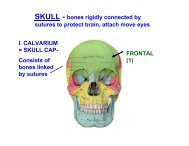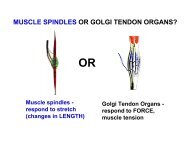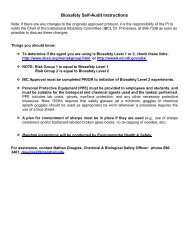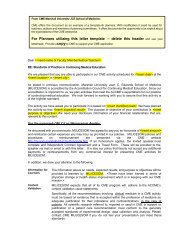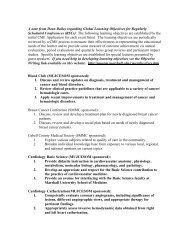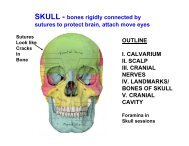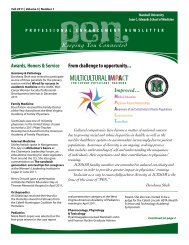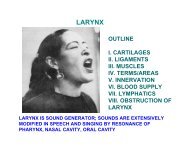Program Director/Principal Investigator (Last, First, Middle): Rankin, Gary O 46and their receptors and have demonstrated that both fibroblast growth factors and their receptorsare expressed by meningioma cells. Further, growth factor message levels are modulated bysteroid hormones. Treatment <strong>of</strong> meningioma cells with antagonists <strong>of</strong> FGF receptors decreasesthe proliferation <strong>of</strong> the cells and the phosphorylation <strong>of</strong> ERK1 and 2. Together, these resultsprovide more evidence that steroid hormones may affect the expression <strong>of</strong> fibroblast growth factors(FGF2 and FGF9) in meningiomas and also that an FGF autocrine loop plays a role in meningiomacell proliferation, partially by signaling through ERK1/2.Of other genes identified to examine in specific aims 1 and2, we have found that the expression <strong>of</strong>the cyclin dependent kinase p27 kip1 (CDKN1B) is modulated in meningioma cells by both theprogesterone antagonist Mifepristone and the histone deacetylase inhibitor butyric acid. Thetranscriptional repressor KLF10 (Krueppel-like factor 10 or TIEG-1) was down regulated by a factor<strong>of</strong> 32 by the estrogen receptor antagonist, ZK164015 in more aggressive lines <strong>of</strong> meningioma,while Mifepristone had no effect. Since PR is typically higher in lower grades <strong>of</strong> meningioma whileER increases in higher grades, we are examining this in cells from lower grade tumors. KLF10expression also was modulated by butyric acid.Although SLC20A2 (GLVR-2, Pit2) was not highlighted in the grant, we found that its expressionwas significantly down regulated by Mifepristone. Expression was also modulated by HDACinhibitor treatment. Little is known about this gene outside <strong>of</strong> its function in the kidney, although ithas been focus <strong>of</strong> gene therapy work as the Gibbon ape leukemia virus receptor 2, and wespeculate that it may be involved in the calcification <strong>of</strong> the tumors.The work <strong>of</strong> one graduate student who graduated during the past year was published during thesummer: Manohar S, Harlow M, Nguyen H, Li J, Hankins GR, Park M, Chromatin modifying protein1A (Chmp1A) <strong>of</strong> the endosomal sorting complex required for transport (ESCRT)-III family activatesataxia-telangiectasia mutated (ATM) for PanC-1 cell growth inhibition. Cell Cycle 10 (15):2529-2539, 2011. Although Dr. Park has left Marshall University and Dr. Travis Salisbury hasreplaced her as the mentor, we are still collaborating on studies on chromatin modifying proteins.Dr. Salisbury’s research on the aryl hydrocarbon receptor complements the grant research giventhe parallels and crosstalk between AHR and steroid receptors.PROTECTION AGAINST RESEARCH RISKSN 1. Will human subjects be involved next year?N 2. Will vertebrate animals be used next year?N 3. Will recombinant DNA experiment(s) be conducted next year?N 4. Are there potential hazards to laboratory workers (carcinogens, pathogens, ionizing radiation, etc.)involved in the proposed research for next year? If yes, identify:N5. Will any <strong>of</strong> the research-risk categories,not involved next year, be involved future years? If yes, identify:PHS 2590 (Rev. 06/09)Continuation Format Page
Program Director/Principal Investigator (Last, First, Middle): Rankin, Gary O 47MECHANOTRANSDUCTION, INTRACELLULAR SIGNALING AND VASCULAR BIOLOGY(0022)TYPE:Research Subproject%IDeA $: 5.000% IDeA $: 175,256INVESTIGATOR, DEGREEHarris, Rob PHDBlough, Eric PHDDEPARTMENTBiologyBiological SciencesNON-HOST INSTITUTION: STATE,COUNTRYWest Virginia State University, Wv UsaTotal # human subjects expected for entire study: 0Total # human subjects enrolled to date: 0SUBPROJECT DESCRIPTIONA fundamental problem in biology is to understand how cells are able to sense and respond toenvironment cues. The integration <strong>of</strong> chemical signals such as growth factors and cytokines withmechanical stimuli is not well understood. The place where cascades involved in solid-state (mechanical)signaling and soluble (chemical) signaling converge and the manner in which they interact is no doubtcomplex. This research project is designed to investigate signaling events associated with both chemicaland mechanical stimuli. Cells <strong>of</strong> the vascular system are continuously exposed to the effects <strong>of</strong> mechanicalforces such as stretching and fluid shear stress. These forces, which are created by the pulsatile nature <strong>of</strong>blood flow when the heart contracts and relaxes, have a marked influence on cell structure and function. Theadaptations <strong>of</strong> these cells, including enhanced growth and migration, seem to be important in thepathological conditions that accompany cardiovascular diseases such as atherosclerosis, hypertension,and restenosis. Cardiovascular disease remains a major cause <strong>of</strong> morbidity and mortality in the U.S. and theeconomic and human costs associated with these pathologies are enormous. This has resulted in an intenseresearch interest in the mechanisms which regulate contraction, migration, and growth <strong>of</strong> vascular smoothmuscle cells (VSMC). While it is now clear that mechanical forces imposed on cells <strong>of</strong> the vessel wall areimportant factors in the initiation and progression <strong>of</strong> pathological changes, the molecular mechanismsinvolved in these adaptations are not fully understood. In addition, it is now clear that the basic mechanism <strong>of</strong>smooth muscle contraction can only be explained in light <strong>of</strong> actin remodeling. However, the exact nature <strong>of</strong>cytoskeletal reorganization and the mechanisms regulating these changes are not well known. The overallgoal <strong>of</strong> this project is to elucidate the acute responses in cytoskeletal reorganization that occur duringmechanical stress <strong>of</strong> VSMC and to determine the intracellular signaling mechanisms that are involved.Utilizing molecular approaches combined with fluorescence microscopy, and relying on theprecise changes in cell orientation and actin cytoskeletal reorganization as endpoints for quantitativeassessment <strong>of</strong> responsiveness to mechanical strain, we will evaluate the role <strong>of</strong> various cytoskeletalstructures on the response <strong>of</strong> VSMC to stretch. Further, we will make a systematic determination <strong>of</strong> theeffects <strong>of</strong> various types <strong>of</strong> mechanical stress on activation <strong>of</strong> cell signaling molecules. In addition, we willevaluate the effects <strong>of</strong> resveratrol, a purported cardioprotective molecule, for its potential effects onstretch-induced cell signaling and receptor mediated cellular hypertrophy. The use <strong>of</strong> pharmacologic andmolecular techniques to stabilize, destabilize or down-regulate specific cytoskeletal components isexpected to provide clear answers concerning the role <strong>of</strong> specific components in mechanotransduction andthe cell orientation response. The inhibition or down-regulation <strong>of</strong> specific signaling proteins is expected toprovide information concerning pathways regulating mechanosensing and transduction. The knowledgegained may be useful in the development <strong>of</strong> therapeutic agents regulating mechanotransductionmechanisms contributing to cardiovascular pathologies.SUBPROJECT PROGRESSAmong the changes in gene expression that we have found to be associated with mechanicalstress is the the giant protein titin. The role <strong>of</strong> titin in organizing and stabilizing contractile filamentsin sarcomeres <strong>of</strong> striated muscle is well understood. Titin forms filaments in cardiac and skeletalmuscle that provide elasticity in relaxed cells but limit cell lengthening and as such contribute tooverall stiffness. Since its discovery nearly a decade ago, the function <strong>of</strong> smooth muscle (SM) titinPHS 2590 (Rev. 06/09)Continuation Format Page



